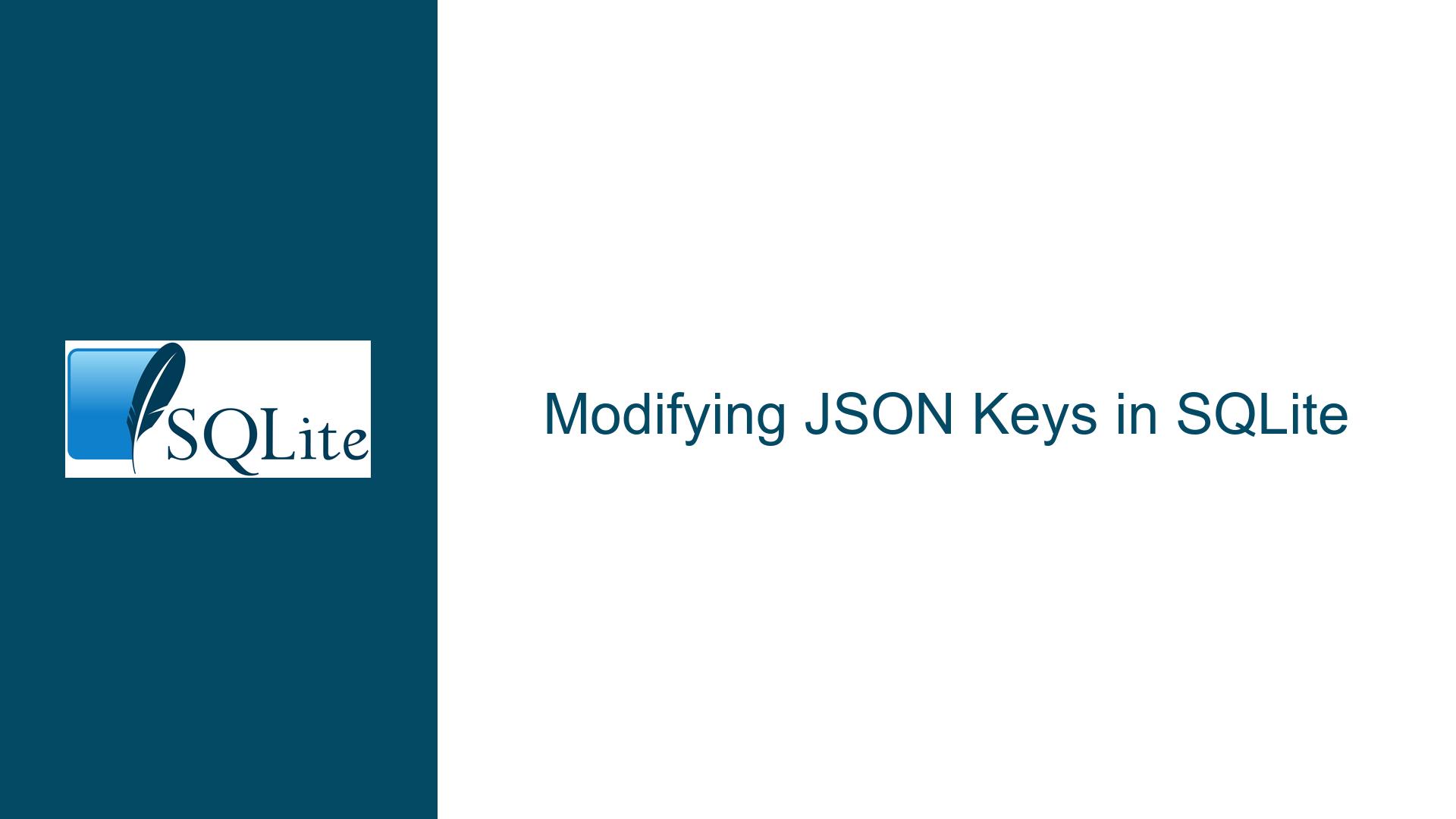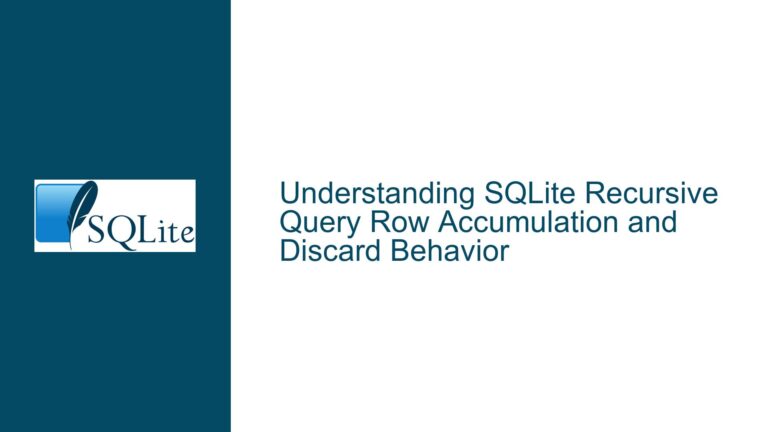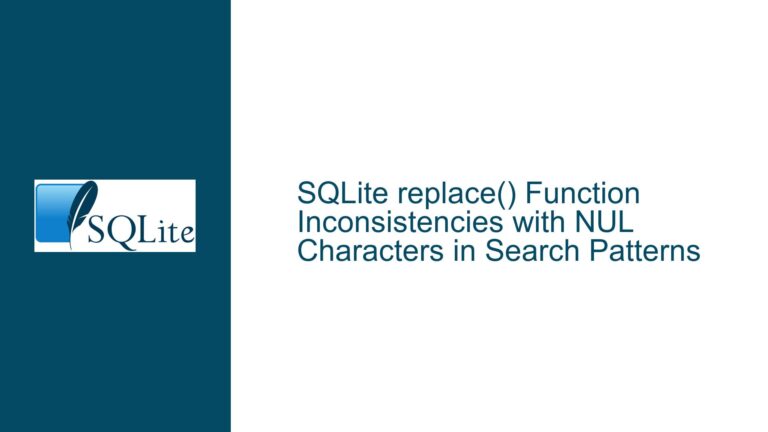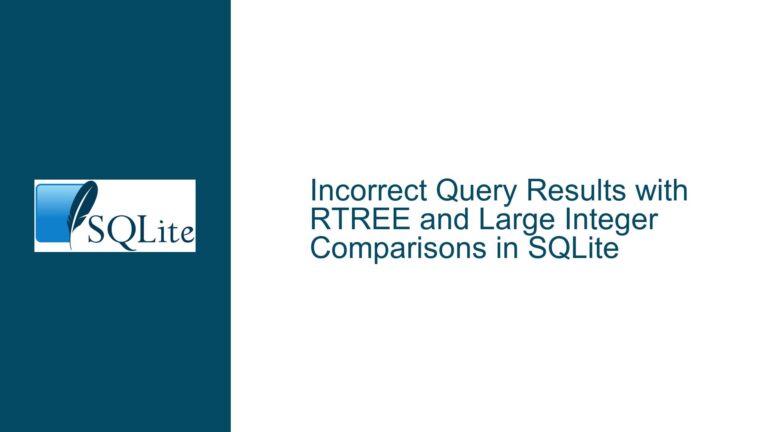Modifying JSON Keys in SQLite
Understanding JSON Key Modification in SQLite
In the realm of SQLite, handling JSON data can often present unique challenges, particularly when it comes to modifying keys within JSON objects. The issue at hand revolves around a common scenario: extracting sensor readings stored as JSON key-value pairs in a database and replacing the integer keys with their corresponding textual descriptions from a reference table. This process is essential for making the data more interpretable and user-friendly, especially in applications that rely on human-readable formats for reporting or analysis.
The structure of the database involves two tables: measurement_definition, which contains integer keys and their associated descriptions, and reading, which holds timestamps and JSON-formatted sensor readings. The goal is to transform the JSON data in the reading table so that the integer keys are replaced by their respective descriptions from the measurement_definition table. This transformation not only enhances readability but also facilitates easier interpretation of sensor data by users who may not be familiar with the numeric codes.
The challenge arises from SQLite’s capabilities regarding JSON manipulation. While SQLite provides several functions to work with JSON data, direct modification of keys within a JSON object is not inherently supported. Instead, developers must rely on a combination of extraction, transformation, and reinsertion techniques to achieve the desired outcome.
Analyzing Potential Causes for Key Modification Challenges
There are several factors that contribute to the difficulties encountered when attempting to modify JSON keys in SQLite. Understanding these causes is crucial for developing effective solutions.
Limitations of SQLite’s JSON Functions: SQLite offers various JSON functions such as
json_each,json_group_object, and others that allow for extraction and aggregation of JSON data. However, these functions do not provide a straightforward method for directly modifying existing keys within a JSON object. This limitation necessitates a workaround approach involving multiple steps.Complexity of Nested Data Structures: In cases where JSON objects contain nested structures or arrays, the complexity increases significantly. Handling nested data requires careful consideration of how to traverse these structures while ensuring that key modifications are applied correctly without losing data integrity.
Data Integrity and Type Consistency: When modifying keys in JSON objects, maintaining data integrity is paramount. If the transformation process inadvertently alters the types or structure of the data (for example, converting numbers to strings), it can lead to inconsistencies that compromise the reliability of subsequent analyses or queries.
Performance Considerations: Depending on the size of the dataset and the complexity of the JSON structures involved, performance can become a concern. Inefficient queries or excessive transformations may lead to slow execution times, particularly when dealing with large volumes of data.
User Error in Query Construction: Crafting SQL queries to manipulate JSON data can be intricate, especially for those who may not be familiar with SQLite’s syntax or its specific functions for handling JSON. Misunderstandings or oversights in query construction can result in errors or unexpected outcomes.
Detailed Troubleshooting Steps, Solutions & Fixes
To effectively address the issue of modifying JSON keys in SQLite, we can outline a systematic approach that encompasses troubleshooting steps and potential solutions.
Step 1: Extracting Values from JSON
The first step involves extracting values from the existing JSON objects stored in the reading table. This can be accomplished using SQLite’s json_each function, which allows you to iterate over each key-value pair in a JSON object.
SELECT timestamp,
key,
value
FROM reading,
json_each(reading.reading);
This query retrieves each timestamp along with its corresponding key and value from the JSON data. The output will provide insight into how many keys exist and what their current values are.
Step 2: Joining with Measurement Definitions
Next, we need to join this extracted data with the measurement_definition table to obtain the corresponding descriptions for each integer key.
SELECT r.timestamp,
md.measurement_description,
je.value
FROM reading AS r
JOIN json_each(r.reading) AS je ON je.key = md.measurement_key
JOIN measurement_definition AS md ON md.measurement_key = je.key;
This query combines information from both tables based on matching keys, yielding a result set that includes timestamps alongside their human-readable descriptions and values.
Step 3: Reconstructing Modified JSON Objects
Once we have successfully mapped integer keys to their textual descriptions, we can reconstruct new JSON objects using the json_group_object function. This function aggregates key-value pairs into a new JSON object format.
SELECT timestamp,
json_group_object(md.measurement_description, je.value) AS modified_reading
FROM reading AS r
JOIN json_each(r.reading) AS je ON je.key = md.measurement_key
JOIN measurement_definition AS md ON md.measurement_key = je.key
GROUP BY r.timestamp;
This query groups results by timestamp while creating new JSON objects where integer keys have been replaced by their respective descriptions.
Step 4: Updating the Reading Table
With our modified JSON objects prepared, we can now update the original reading table to reflect these changes. To do this safely without losing existing data during transformation:
- Create a temporary table to hold modified readings.
- Insert modified readings into this temporary table.
- Replace original readings with updated ones from the temporary table.
- Drop the temporary table once updates are complete.
CREATE TABLE temp_reading AS
SELECT timestamp,
json_group_object(md.measurement_description, je.value) AS modified_reading
FROM reading AS r
JOIN json_each(r.reading) AS je ON je.key = md.measurement_key
JOIN measurement_definition AS md ON md.measurement_key = je.key
GROUP BY r.timestamp;
DELETE FROM reading;
INSERT INTO reading (timestamp, reading)
SELECT timestamp, modified_reading FROM temp_reading;
DROP TABLE temp_reading;
Step 5: Validating Changes
After performing updates on the reading table, it is crucial to validate that changes have been applied correctly:
- Run queries to check if all expected keys have been replaced by their corresponding descriptions.
- Ensure that no data has been lost during transformations.
- Verify performance metrics if applicable—ensure that query execution times remain acceptable post-modification.
Conclusion
Modifying keys within JSON objects in SQLite requires careful planning and execution due to inherent limitations within SQLite’s handling of JSON data structures. By following these structured troubleshooting steps—extracting values, joining with reference definitions, reconstructing new objects, updating tables safely, and validating changes—developers can effectively transform their datasets into more user-friendly formats without compromising integrity or performance.
This approach not only addresses immediate concerns regarding key modification but also establishes best practices for future interactions with similar datasets within SQLite environments. As developers continue to explore the capabilities of SQLite’s JSON functions, they will find that understanding these nuances enhances both their efficiency and effectiveness in managing complex data scenarios.






